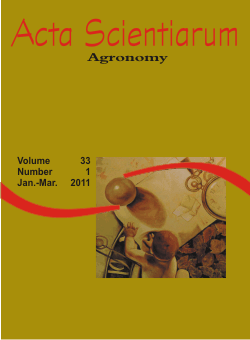<b>Physiological traits for drought phenotyping in cotton</b> - doi: 10.4025/actasciagron.v33i1.9839
Resumo
The objective of this study was to identify physiological traits that could distinguish between cotton genotypes that were tolerant or sensitive to water deficits. The experiment was conducted in a completely randomized design through a factorial combination to analyze four genotypes (BRS 187 8H and ACALA SJ-4 - water deficit tolerant; CNPA 7H and SU-0450/8909 - water deficit sensitive) and two water regimes (watered/always irrigated and stressed/with a water deficit imposed at flowering). Irrigation was suspended for the plants in the water deficit treatment groups when their first flowers appeared. Leaf water potential (ψpd) was monitored until the plants reached -3.0 MPa predawn, at which point leaf samples were collected for analysis. The plants were re-irrigated and monitored for a recovery to 50% of leaf water potential. The maximum photochemical efficiency (Fv/Fm), chlorophyll content (SPAD index), relative water content (RWC), disruption of the cell membrane via membrane leakage, carbon isotope composition (δ13C), seed cotton yield and fiber quality were evaluated. The trends in membrane leakage and carbon isotope composition were different between the tolerant and sensitive genotypes under a water deficit, which makes these physiological traits suitable for screening for tolerance to water deficits in cotton.Downloads
DECLARAÇÃO DE ORIGINALIDADE E DIREITOS AUTORAIS
Declaro que o presente artigo é original, não tendo sido submetido à publicação em qualquer outro periódico nacional ou internacional, quer seja em parte ou em sua totalidade.
Os direitos autorais pertencem exclusivamente aos autores. Os direitos de licenciamento utilizados pelo periódico é a licença Creative Commons Attribution 4.0 (CC BY 4.0): são permitidos o compartilhamento (cópia e distribuição do material em qualqer meio ou formato) e adaptação (remix, transformação e criação de material a partir do conteúdo assim licenciado para quaisquer fins, inclusive comerciais.
Recomenda-se a leitura desse link para maiores informações sobre o tema: fornecimento de créditos e referências de forma correta, entre outros detalhes cruciais para uso adequado do material licenciado.




























